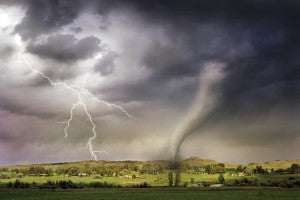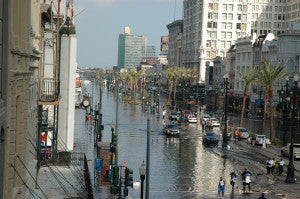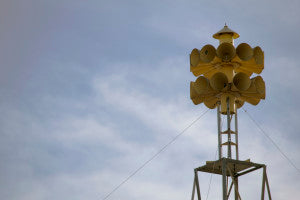By Melissa Rivera

In the 1996 movie Twister, Helen Hunt’s and Bill Paxton’s characters explained why they wanted to get information from the inside of a tornado.
“If we knew how a tornado really worked, we could design an advance warning system. … Right now, it's three minutes. If we can get this new information, we can increase warning time to 15 minutes. Give people a chance to get to safety.”
Today, the average amount of lead time between the tornado warning and a tornado strike is
13 minutes. And the National Weather Service last year predicted a possible tornado outbreak six days in advance.
Scientific studies before, during, and after disasters can help people better prepare for, better respond to, and
better recover from disasters. If people use them correctly, that is.
For example, volcanologists are using GPS data to develop models for how the earth rises and falls in response to magma flow. They’re using that information to develop models for when
volcanic eruptions might occur, the same way meteorologists look at weather measurements and plug them into models to forecast the weather. Wouldn’t it be nice for communities around a volcano to have a good idea when an eruption is imminent so they could evacuate in time? That’s especially valuable in a place like Naples, Italy, where more than a
million people live in a volcanically active area

Another example: This hurricane season, for the first time, the National Weather Service will send out storm surge alerts separate from hurricane alerts.
Storm surge is a bubble of water that hurricane winds create. When it comes ashore, it’s the most destructive part of a hurricane –
it caused most of Hurricane Katrina’s 1,200 deaths. But it might not come ashore at the same place or time as the hurricane. Hurricane Ike, for example, came ashore at Galveston, Texas. Yet its
storm surge caused major flooding around Lake Pontchartrain, La. Storm surge watches and warnings can help people better prepare for the different types of severe weather hurricanes bring. People should evacuate from a storm surge, Rick Knabb, the hurricane expert at the Weather Channel told
USA Today, but they can shelter in place from the wind if they’re not in a flood-prone area.
Science can also help people better respond to emergencies and natural disasters while they’re happening. One way to do that is to practice disaster response, according to Ready.gov.
“Post-incident critiques often confirm that experience gained during exercises was the best way to prepare teams to respond effectively to an emergency,” the site said.
Scientists are proposing reasons for that, too. One study suggests that practicing the piano increases white matter in certain parts of pianists’ brains. White matter is connective brain tissue, sort of like phone lines that link to the different parts of the brain,
according to an article in Scientific American. Studies are now showing this white matter could play an important role in learning. If you practice a skill frequently, your brain could develop communication pathways to make that skill easier. So, if you frequently think about and practice how you want to react in an emergency situation, you’ll be better at reacting if the situation actually comes along.
Science can also help individuals and communities recover from disasters. After years of drought, Atlanta officials passed a tax to fund a water storage project in order to expand the city’s emergency water supply from three days to a month.
A story in the Christian Science Monitor suggested one reason for the vote is people there realized how vulnerable their water supply could be. Contamination of water supplies in places like Flint, Mich., is waking up other municipalities to the realization that they need to be prepared so they can smoothly recover from problems with their own supply.

A tough part of meteorologists’ jobs is figuring out how far in advance to warn people.
In a study published in 2011, researchers found a longer warning time before a tornado would make more than 44 percent of respondents feel that the situation was less life threatening.
So, why provide a forecast with such a long lead time? One meteorologist told the Associated Press he wanted people to take the additional time to prepare.
"Can they go out and buy a weather radio this weekend? Can you vacuum the spider webs out of your storm shelter?" asked Rick Smith, the warning coordination meteorologist for the National Weather Service in Norman. "It's April. We're in Oklahoma and Texas. We need to be doing this anyway."
Melissa Rivera is a jack-of-all-trades who is master of none. She has been a writer and editor for more than 15 years.

 In the 1996 movie Twister, Helen Hunt’s and Bill Paxton’s characters explained why they wanted to get information from the inside of a tornado.
“If we knew how a tornado really worked, we could design an advance warning system. … Right now, it's three minutes. If we can get this new information, we can increase warning time to 15 minutes. Give people a chance to get to safety.”
Today, the average amount of lead time between the tornado warning and a tornado strike is 13 minutes. And the National Weather Service last year predicted a possible tornado outbreak six days in advance.
Scientific studies before, during, and after disasters can help people better prepare for, better respond to, and better recover from disasters. If people use them correctly, that is.
For example, volcanologists are using GPS data to develop models for how the earth rises and falls in response to magma flow. They’re using that information to develop models for when volcanic eruptions might occur, the same way meteorologists look at weather measurements and plug them into models to forecast the weather. Wouldn’t it be nice for communities around a volcano to have a good idea when an eruption is imminent so they could evacuate in time? That’s especially valuable in a place like Naples, Italy, where more than a million people live in a volcanically active area
In the 1996 movie Twister, Helen Hunt’s and Bill Paxton’s characters explained why they wanted to get information from the inside of a tornado.
“If we knew how a tornado really worked, we could design an advance warning system. … Right now, it's three minutes. If we can get this new information, we can increase warning time to 15 minutes. Give people a chance to get to safety.”
Today, the average amount of lead time between the tornado warning and a tornado strike is 13 minutes. And the National Weather Service last year predicted a possible tornado outbreak six days in advance.
Scientific studies before, during, and after disasters can help people better prepare for, better respond to, and better recover from disasters. If people use them correctly, that is.
For example, volcanologists are using GPS data to develop models for how the earth rises and falls in response to magma flow. They’re using that information to develop models for when volcanic eruptions might occur, the same way meteorologists look at weather measurements and plug them into models to forecast the weather. Wouldn’t it be nice for communities around a volcano to have a good idea when an eruption is imminent so they could evacuate in time? That’s especially valuable in a place like Naples, Italy, where more than a million people live in a volcanically active area
 Another example: This hurricane season, for the first time, the National Weather Service will send out storm surge alerts separate from hurricane alerts. Storm surge is a bubble of water that hurricane winds create. When it comes ashore, it’s the most destructive part of a hurricane – it caused most of Hurricane Katrina’s 1,200 deaths. But it might not come ashore at the same place or time as the hurricane. Hurricane Ike, for example, came ashore at Galveston, Texas. Yet its storm surge caused major flooding around Lake Pontchartrain, La. Storm surge watches and warnings can help people better prepare for the different types of severe weather hurricanes bring. People should evacuate from a storm surge, Rick Knabb, the hurricane expert at the Weather Channel told USA Today, but they can shelter in place from the wind if they’re not in a flood-prone area.
Science can also help people better respond to emergencies and natural disasters while they’re happening. One way to do that is to practice disaster response, according to Ready.gov.
“Post-incident critiques often confirm that experience gained during exercises was the best way to prepare teams to respond effectively to an emergency,” the site said.
Scientists are proposing reasons for that, too. One study suggests that practicing the piano increases white matter in certain parts of pianists’ brains. White matter is connective brain tissue, sort of like phone lines that link to the different parts of the brain, according to an article in Scientific American. Studies are now showing this white matter could play an important role in learning. If you practice a skill frequently, your brain could develop communication pathways to make that skill easier. So, if you frequently think about and practice how you want to react in an emergency situation, you’ll be better at reacting if the situation actually comes along.
Science can also help individuals and communities recover from disasters. After years of drought, Atlanta officials passed a tax to fund a water storage project in order to expand the city’s emergency water supply from three days to a month. A story in the Christian Science Monitor suggested one reason for the vote is people there realized how vulnerable their water supply could be. Contamination of water supplies in places like Flint, Mich., is waking up other municipalities to the realization that they need to be prepared so they can smoothly recover from problems with their own supply.
Another example: This hurricane season, for the first time, the National Weather Service will send out storm surge alerts separate from hurricane alerts. Storm surge is a bubble of water that hurricane winds create. When it comes ashore, it’s the most destructive part of a hurricane – it caused most of Hurricane Katrina’s 1,200 deaths. But it might not come ashore at the same place or time as the hurricane. Hurricane Ike, for example, came ashore at Galveston, Texas. Yet its storm surge caused major flooding around Lake Pontchartrain, La. Storm surge watches and warnings can help people better prepare for the different types of severe weather hurricanes bring. People should evacuate from a storm surge, Rick Knabb, the hurricane expert at the Weather Channel told USA Today, but they can shelter in place from the wind if they’re not in a flood-prone area.
Science can also help people better respond to emergencies and natural disasters while they’re happening. One way to do that is to practice disaster response, according to Ready.gov.
“Post-incident critiques often confirm that experience gained during exercises was the best way to prepare teams to respond effectively to an emergency,” the site said.
Scientists are proposing reasons for that, too. One study suggests that practicing the piano increases white matter in certain parts of pianists’ brains. White matter is connective brain tissue, sort of like phone lines that link to the different parts of the brain, according to an article in Scientific American. Studies are now showing this white matter could play an important role in learning. If you practice a skill frequently, your brain could develop communication pathways to make that skill easier. So, if you frequently think about and practice how you want to react in an emergency situation, you’ll be better at reacting if the situation actually comes along.
Science can also help individuals and communities recover from disasters. After years of drought, Atlanta officials passed a tax to fund a water storage project in order to expand the city’s emergency water supply from three days to a month. A story in the Christian Science Monitor suggested one reason for the vote is people there realized how vulnerable their water supply could be. Contamination of water supplies in places like Flint, Mich., is waking up other municipalities to the realization that they need to be prepared so they can smoothly recover from problems with their own supply.
 A tough part of meteorologists’ jobs is figuring out how far in advance to warn people. In a study published in 2011, researchers found a longer warning time before a tornado would make more than 44 percent of respondents feel that the situation was less life threatening.
So, why provide a forecast with such a long lead time? One meteorologist told the Associated Press he wanted people to take the additional time to prepare.
"Can they go out and buy a weather radio this weekend? Can you vacuum the spider webs out of your storm shelter?" asked Rick Smith, the warning coordination meteorologist for the National Weather Service in Norman. "It's April. We're in Oklahoma and Texas. We need to be doing this anyway."
Melissa Rivera is a jack-of-all-trades who is master of none. She has been a writer and editor for more than 15 years.
A tough part of meteorologists’ jobs is figuring out how far in advance to warn people. In a study published in 2011, researchers found a longer warning time before a tornado would make more than 44 percent of respondents feel that the situation was less life threatening.
So, why provide a forecast with such a long lead time? One meteorologist told the Associated Press he wanted people to take the additional time to prepare.
"Can they go out and buy a weather radio this weekend? Can you vacuum the spider webs out of your storm shelter?" asked Rick Smith, the warning coordination meteorologist for the National Weather Service in Norman. "It's April. We're in Oklahoma and Texas. We need to be doing this anyway."
Melissa Rivera is a jack-of-all-trades who is master of none. She has been a writer and editor for more than 15 years.


